Engagement Models for software development
What is an Engagement Model?
Engagement model serves as a basis for future client-vendor relationships. It’s a framework a company chooses to manage their customers that serves as a basis of their future collaboration between a client and a software vendor that ensures the level of control, responsibility or flexibility.
Just like there’s no such thing as a universal client, there’s no one way of collaborating. Choosing the appropriate engagement model for software development is the primary task aimed to align goals around a common outcome and the best suitable pricing model. The decision to choose this or that engagement model can be based on various factors that might be objective like the maturity level of vendor and their track record of success, or subjective like customer’s previous experiences with other service providers.
Either way, the selected model with all its legal and technological aspects should be precisely specified and transparent for both parties. Here’s our brief overview and discussion of the most popular models of software engagement: Dedicated Team, Time and Material, Fixed Bid and Outstaffing/Augmentation.
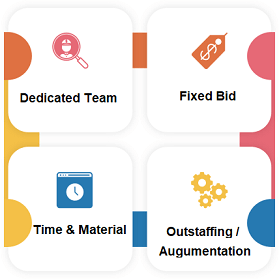
1. Dedicated Team
A project engagement model with a dedicated team means an extension of the client’s team with the offshore, nearshore, or onshore vendors’ specialists, while the other project members are retained on the client’s side. The specialists, your firm is supplemented with are supposed to entirely comply with the existing corporate culture, rules, and best practices of your company. Moreover, this new team takes over your company’s technical resources, tools, and methodologies, and should be expected to recognize themselves as an important part of the organization.
A project engagement model with a dedicated team means an extension of the client’s team with the offshore, nearshore, or onshore vendors’ specialists, while the other project members are retained on the client’s side. The specialists, your firm is supplemented with are supposed to entirely comply with the existing corporate culture, rules, and best practices of your company. Moreover, this new team takes over your company’s technical resources, tools, and methodologies, and should be expected to recognize themselves as an important part of the organization.
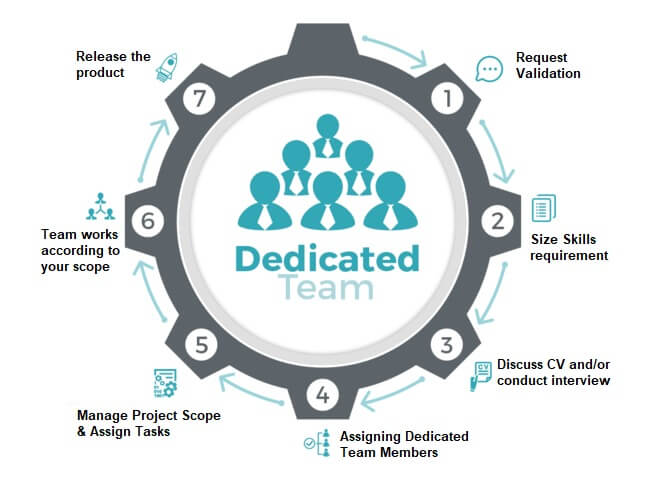
When to Use?
This model is perfect for all types of projects. The team is 100% dedicated to the project and managed by the customer.
Pros of Dedicated Team Model
- Highly Cost-Effective and Engaging
- Control over Resources
- Highly Flexible
Cons of Dedicated Team Model
- Not Suitable for Short-term Projects
- Requires Continuous Client Dedication
2. Time & Material
A cost-effective model where the amount of money you spend corresponds to the amount of work delivered. The client and the vendor usually agree upon an hourly, daily, or weekly rate for the allocated project resources. This engagement model is often preferred because it offers flexibility to change requirements on the fly, the ability to balance project resources, and spread the workload.
Provided that Time & Material project is accompanied by experienced and skilled project managers, quality is properly supervised. Progress and the observance of the deadline are not neglected. There are good chances of getting the work done in time and within the budget.
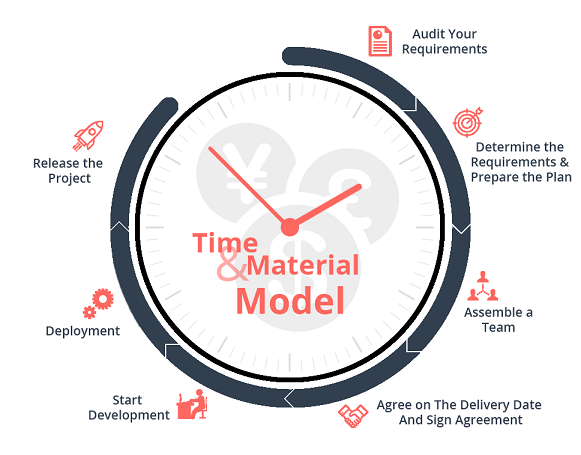
When to Use?
In a T&M contract, the customer should be able to estimate the hours needed for a job and negotiate lower hourly rates to reduce the total software development cost.
Pros of Time & Material Model
- Pay for the Services You Use
- Higher Degree of Flexibility
- More Control
Cons of Time & Material Model
- No Set Timeframe
- Unprecise Cost Estimations
3. Fixed Bid
Fixing the price is about fixing the scope, project requirements, as well as deadlines. This model will never work without thorough initial planning, estimation, and analysis sessions. The more planning you do, the better the outcome.
Why is the planning stage so important? The success of the fixed price project is directly proportional to the success of this initial phase. The slightest change in the scope can turn into endless negotiations between the parties with a negative impact on a product’s time-to-market. The main benefit of selecting this particular engagement model is a predefined and fixed project’s budget, which means you know exactly how much you are going to spend on your product, but the cost may vary widely because of the smallest changes in the scope.
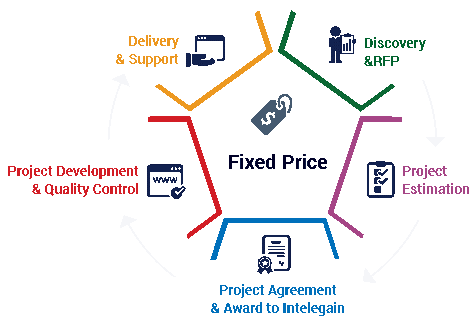
When to Use?
Ideal for small-size or urgent projects. Fixed bid perfectly works when the project specifications are clearly defined and unlikely to change.
Pros of Fixed Bid Model
- Tight Control over the Costs
- Higher Visibility and Transparency
- Requires Little Client Supervision
- Certain Final Outcomes
Cons of Fixed Bid Model
- Little to No Flexibility
- High Communication Gaps
- Uncertain Results
4. Outstaffing / Augmentation
Outstaffing / Augmentation is a type of indirect employment in which a staffing agency provides the services of staffing, retaining, and overseeing full-time talent for a Company. The staffing agency also covers legal aspects of cooperation, provides workspace and IT support to the out-staffed team members, pays their salaries, recruits new talent, and conducts HR processes.
Staff augmentation, which temporarily boosts your software engineering team’s numbers with capable staff throughout a project, or during specific phases, is one delivery approach an IT staffing agency can provide you with that will help you hold onto your competitive advantage.
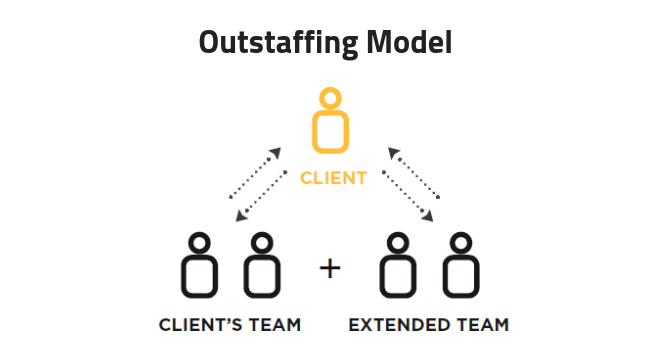
When to Use?
This software development model implies hiring specialists with certain skills and experience in order to temporarily extend your existing in-house team while the additional workforce is required.
Pros of Outstaffing / Augmentation Model
- Control over the development process
- Cost Effective
- Flexibility
- Simple & Fast Hiring
Cons of Outstaffing / Augmentation Model
- Training of candidates
- Low productivity in the early stages
Choosing The Best Model
Choosing the best model for your project fully depends on your needs. Depending on the project you must decide which one is most suitable for you. Each one has clear specifics.
You should understand which of the models will be the least risky for you. You can outline all the pros and cons. Go through every aspect, and you will undoubtedly arrive at an informed decision.
Read more blogs here